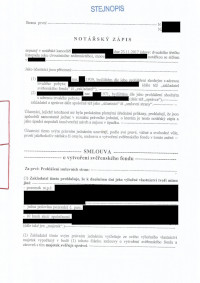Trusts, which were introduced in 2014, are still a relatively new tool in the Czech Republic.
Since that time many professionals and other advisers have started to offer trusts as a tool to help clients achieve many goals, including;
- protecting family assets from external attack,
- better managing family inheritance, especially in the case of complex families
- Passing family businesses from one generation to the
Unfortunately, not all of these advisers have the skills and knowledge to do this job properly.
Here’s one example:
 We have linked here to a trust statute from the public register of trusts. This is one of many examples of ‘not so great’ trusts, often the result of someone trying to save money.
We have linked here to a trust statute from the public register of trusts. This is one of many examples of ‘not so great’ trusts, often the result of someone trying to save money.
You may ask us how we can show you someone’s trust document. That’s because whoever established this trust omitted to inform the court that the document should not be published (Mistake number 1).
Because we very much doubt that the clients involved actually wanted their private affairs to be public, we have redacted their names and other identifying details. If you are curious you can find this, and many other similar trusts open to public view on the register of trusts
Ignoring the notarial preamble, this document has two pages of actual content. In our experience, it is impossible to make a robust trust with less than 10 pages, and good documents typically run to about 30-40 pages. This one is much too short (Mistake number 2). If your trust is less than 10 pages long, we recommend you seek help immediately.
The beneficiary of this trust is also the only trustee. That is directly in conflict with the provisions of the Civil Code which require there should be at least one independent trustee in such a case. That means that this trust probably isn’t valid at all (Mistake number 3)
Another problem stemming from this is that the Civil Code says that a trustee cannot make a decision to benefit himself. That means that even if this trust is valid – which we doubt – there is no way to make any payment to the beneficiary (Mistake 4)
When the founder signed this document, he put all the assets in at the beginning meaning that he paid a lot more in notarial fees than was necessary (Mistake 5). There is no reason to do this. In addition to saving a lot of money, it normally makes much more sense to set up the trust first and then put the assets in later. We suspect that this trust may have been done directly by the notary without any legal or expert input. The notary probably did quite well financially from this, but not the client.
This trust has just one beneficiary. What happens if he dies? If his Father (The Founder) is still alive it will go back to him, but if not, then the assets will go to the Czech State. Probably not what the client wanted! (Mistake 6)
There is no mechanism for replacement of the trustee. So what happens if the Trustee dies or retires? If the Founder is no longer alive they’ll have to go to court to solve that one and end up spending a lot more money than they ‘saved’ (Mistake 7)
Beyond that, there are many many things missing that should be here. Exactly what else is missing is difficult to guess without understanding the client’s objective when he set up the Trust.
If the reason for setting up this trust was, or included, protection of the assets against external attack, we doubt very much if this will be effective. There is only one beneficiary who is also the only trustee. This means that in effect, the assets are ‘his’ and are therefore very vulnerable to attack, plus in any case, as discussed above, this probably isn’t a valid trust anyway.
We think this is a great illustration of why you should use an APRSF member to set up your trust. Setting up a trust can be expensive – especially if it is not done correctly.
A list of APRSF members can be found here on the APRSF website.

